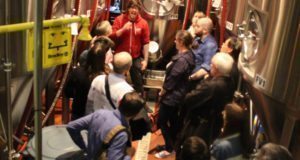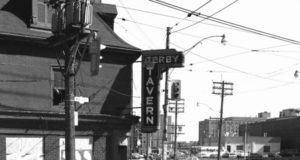Kevin Cooper –
Each year, as part of the curriculum, students of the School of Urban and Regional Planning at Ryerson participate in projects that team up groups of students with actual clients to take on real world planning tasks.
This year, one group—guided by professor Tom Ostler—has been working in conjunction with Sandra Iskandar and the Corktown Residents and Business Association (CRBA) to develop a heritage study for the neighbourhood.
The idea behind the project is to create a detailed inventory of Corktown’s heritage by examining the neighbourhood through five principles: traditional heritage, cultural heritage, lost streets, hidden heritage, and recent heritage.
While the students were able to select examples of traditional heritage that illustrate physical merit and that have shaped the physical landscape of the modern neighbourhood, Corktown’s cultural heritage is arguably the district’s most defining feature: it comprises the importance of the area’s built forms, industrial past and the influence of diverse residents.

The study also deals with heritage aspects that can no longer be seen. For instance, Old Town’s street grid has been constantly evolving, especially in the Corktown area. An analysis of the street network within Corktown was undertaken to determine which streets may have heritage value, as well as examining some that have been removed entirely. Hidden heritage can also exist when a property or area has been renovated or reconstructed beyond its original state, rendering the original built form characteristics as unrecognizable.
With its abundance of Victorian-era architecture, Corktown is often thought of as an historic neighbourhood in traditional terms. However the recent heritage of the neighbourhood is almost as significant to Corktowners. The visual fabric of the modern day Corktown owes as much to postwar era as it does to prior century.
The students hope the report will be a valuable document for future reference for the CRBA in understanding and building on local heritage. Still, some questions remain for the students and their CRBA counterparts: Are heritage “nodes” worthy of preservation? Are Heritage Conservation District designations merited and would they benefit the area and its residents?
Visit www.corktown.ca for more information.
 TheBulletin.ca Journal of Downtown Toronto
TheBulletin.ca Journal of Downtown Toronto


